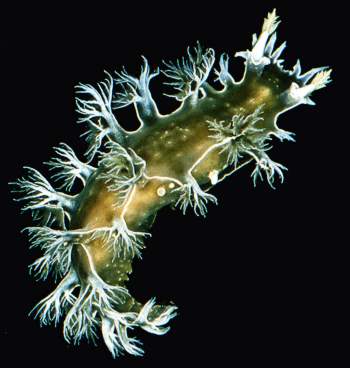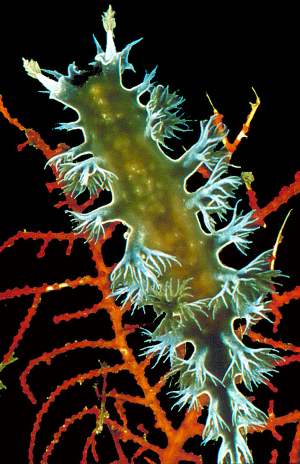Tritonia bollandi from Okinawa
August 16, 2003
From: Vic Smith


Dear Bill,
The animal shown as tritoniid species 8 on the Forum has just been described from Okinawa as Tritonia bollandi in honor of its collector, Robert Bolland. The photos from Indonesia on your message page show a slightly pinker color form than the Okinawan photos, but the animal is clearly the same. It is on its food source in your pictures, a gorgonian in the family Ellisellidae, and appears to be the same one our Okinawan specimens were feeding on, Verrucella aurantia (Gray, 1869). The complete description can be found in the July proceedings of the California Academy of Sciences.
Here is some information for the species Fact Sheet:
Tritonia bollandi Smith and Gosliner, 2003) is described from its type locality of Seragaki Tombs, Okinawa, and has been found at depths of 58 to 75 m. The animal reaches 88 mm in length, and mature specimens are olive green in color, with lighter colored branchial plumes, nearly white rhinophores, and a thin white margin along the notal margin. The body appears granular due to the presence of small low tubercles on all parts of the body, except for the foot. The oral veil is slightly bilobed and bears 12 to 14 elongate digitiform processes, many of which are apically bifid. The notal margin extends along and slightly overhangs the sides of the body. From the notal margin are produced 9 to 14 pairs of arborescent branchial plumes, and the sheaths of the rhinophores, whose margins are undulate and flange-like. The rhinophore shafts are retractable, and are palmate in appearance, with a central clavus surrounded by a stepped series of pinnate processes. External genitalia are on the right side of the animal, behind the third anterior branchial plume. The anus and nephroproct are also on the right side, behind and just below the 4th branchial plume, close to the notal margin. The anterior foot margin is rounded. Tritonia bollandi has been observed to feed upon gorgonian octocorals of the family Ellisellidae (Gray, 1859), in particular Verrucella aurantia (Gray, 1869). This nudibranch is named after the collector. The Indonesian specimens show a slightly different coloration, perhaps due to the depth they were living?
Thanks
Vic Smith
Ecology and systematics
California Academy of Sciences
vsmith@calacademy.org
Smith V.G., 2003 (Aug 16) Tritonia bollandi from Okinawa. [Message in] Sea Slug Forum. Australian Museum, Sydney. Available from http://www.seaslugforum.net/find/10740Dear Vic,
Thanks for the 'Fact Sheet'. It's a great help to get the information straight from the authors.
Best wishes,
Bill Rudman
Related messages
-
Tritonia bollandi from Singapore
From: Lim Han Peng, March 15, 2005 -
Tritonia bollandi from Indonesia
From: Alice Lee, March 22, 2004 -
Tritonia bollandi color variation
From: Bob Bolland, August 19, 2003 -
Tritonia bollandi from Okinawa
From: Bob Bolland, August 16, 2003 -
Tritoniid sp. 8 from Indonesia
From: Nishina Masayoshi, June 2, 2003 -
Tritoniid sp. 8 from Indonesia
From: Jerry Pucelik, May 21, 2003 -
Tritoniopsis? from Indonesia
From: Pat. Danna, February 12, 2003
